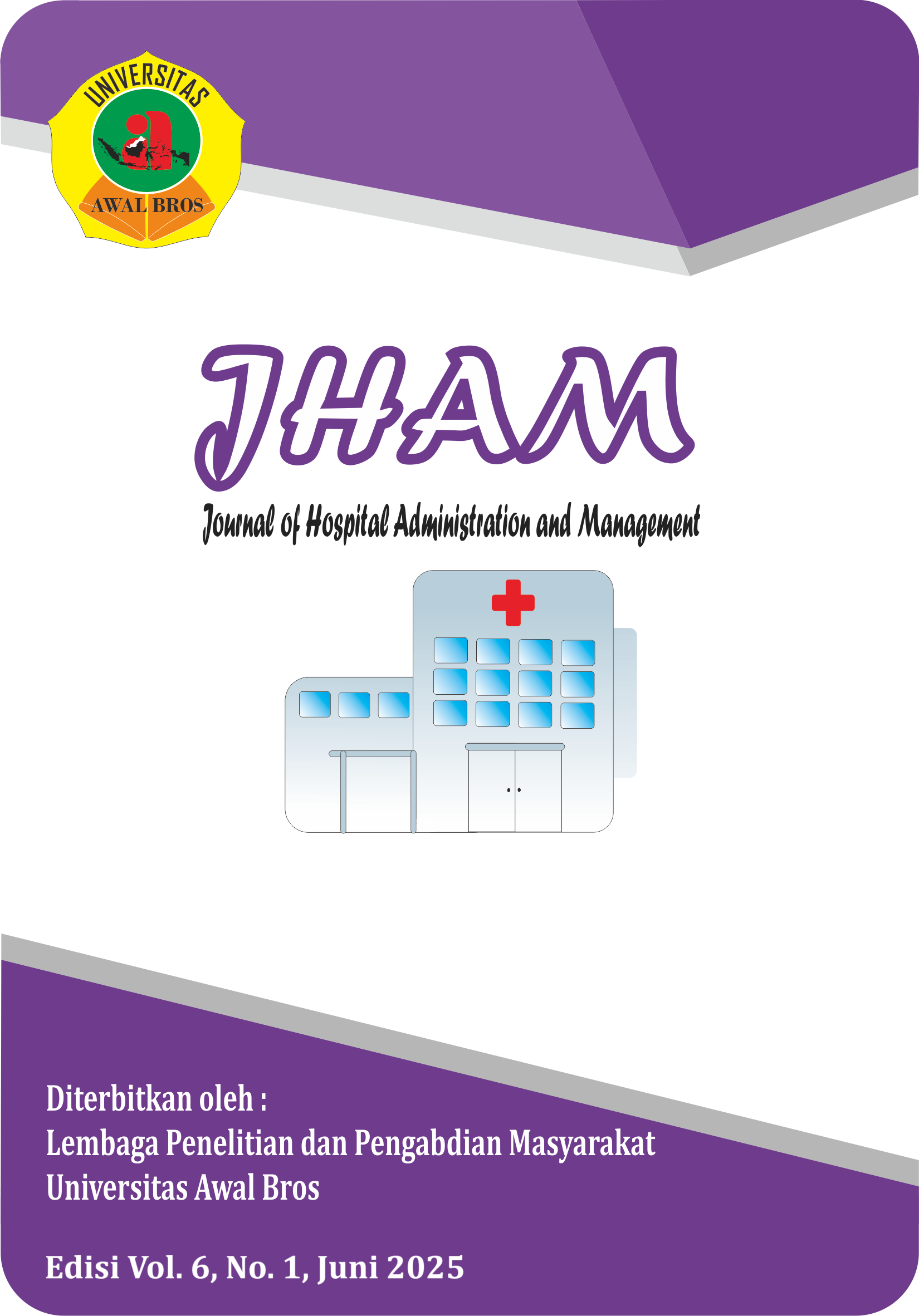DETERMINANTS OF STUNTING IN SOUTHEAST ASIA : A META-ANALYSIS
DOI:
https://doi.org/10.54973/jham.v6i1.647Keywords:
Stunting, LBW, Family Income, Mother's Education, Southeast AsiaAbstract
The problem of stunting (short children) is one of the nutritional problems faced by the world, especially in poor and developing countries. Stunting is a health problem because it is associated with the risk of morbidity and mortality. In 2017, 22.2% or around 150.8 million children under five in the world were stunted. The purpose of this study is to find out what are the determinants of stunting in Southeast Asia using the Meta-analysis research method with analysis of fixed effects models and random effects models. An observational research study site from International articles located in Southeast Asia from 2000-2022. Journals were collected using data based: Google Scholar, Pubmed, Springer Link and Science Direct. The results of the identification of articles were obtained as many as 24 relevant articles entered the meta-analysis stage. The results showed that family income OR 3.26 (95% CI: 1.77-599), LBW OR 2.70 (95% CI: 2.09-3.49), Mother's education OR 1.94 (95% CI : 1.44-2.63) and environmental sanitation OR 1.71 (95% CI: 1.54-1.89). The most influential variable on the determinants of stunting in Southeast Asia is the family income variable. One of the efforts that can be done is to prioritize health promotion with attractive and easily understood media by the public, thereby increasing public awareness of stunting prevention and control efforts
Downloads
References
Anderson, V. P., Cornwall, J., Jack, S., & Gibson, R. S. (2008). Intakes from non-breastmilk foods for stunted toddlers living in poor urban villages of Phnom Penh, Cambodia, are inadequate. Maternal and Child Nutrition, 4(2), 146–159. https://doi.org/10.1111/j.1740-8709.2007.00120.x
Andika, F., Rahmi, N., & Anwar, C. (2020). Analysis of Stunting Incidence Factors in Toddlers Aged 23-59 Months in the Work Area of the Padang Tiji Community Health Center , Pidie Regency , 2020. 642–649.
Aprina, A., & Erwandi, E. (2021). Determinants of Failure to Grow on Toddlers (Stunting). Jurnal Aisyah : Jurnal Ilmu Kesehatan, 6(3), 409–418. https://doi.org/10.30604/jika.v6i3.601
Aridiyah, F. O., Rohmawati, N., & Ririanty, M. (2020). Faktor-faktor yang Mempengaruhi Kejadian Stunting pada Anak Balita di Wilayah Pedesaan dan Perkotaan (The Factors Affecting Stunting on Toddlers in Rural and Urban Areas). e-Jurnal Pustaka Kesehatan., 3 (1)
Arini, D., Chabibah, N., & Agustin, M. A. (2020). Analisa Determinan Sosial Demografi Ibu Terhadap Kejadian Stunting pada Anak Usia Toddler di Wilayah Puskesmas Kenjeran Surabaya. Journal Of Health Science (Jurnal Ilmu Kesehatan), 5(1), 1–10. https://doi.org/10.24929/jik.v5i1.934
Asrianti dkk. (2019). Tingkat Pendapatan, Metode Pengasuhan, Riwayat Penyakit Infeksi dan Risiko Kejadian Stunting pada Balita di Kota Samarinda. Jurnal Nasional Ilmu Kesehatan, 2(1), 1–8. http://journal.unhas.ac.id/index.php/jnik/article/view/6503
Babys, I. Y., Lanti, Y., Dewi, R., & Rahardjo, S. S. (2022). Meta-Analysis the Effect of Complementary Feeding Practice on Stunting in Children Aged 6-59 Months. 07, 465–478.
Bappenas; UNICEF. (2017). Laporan Baseline SDG tentang Anak-Anak di Indonesia. Jakarta: Bappenas dan UNICEF.
Beal, T., Le, D. T., Trinh, T. H., Burra, D. D., Huynh, T., Duong, T. T., Truong, T. M., Nguyen, D. S., Nguyen, K. T., de Haan, S., & Jones, A. D. (2019). Child stunting is associated with child, maternal, and environmental factors in Vietnam. Maternal and Child Nutrition, 15(4), 0–2. https://doi.org/10.1111/mcn.12826
Beal, T., Truong, T. M., Jones, A. D., & Nguyen, D. S. (2019). Child stunting is associated with child , maternal , and environmental factors in Vietnam. March. https://doi.org/10.1111/mcn.12826
Bej, P., Chhabra, P., Sharma, A. K., & Guleria, K. (2013). Determination of Risk Factors for Pre-eclampsia and Eclampsia in a Tertiary Hospital of India : A Case Control Study. 2(4), 371–375. https://doi.org/10.4103/2249-4863.123924
Blankenship, J. L., Cashin, J., Nguyen, T. T., & Ip, H. (2020). Childhood stunting and wasting in Myanmar: Key drivers and implications for policies and programmes. Maternal and Child Nutrition, 16(S2), 1–8. https://doi.org/10.1111/mcn.12710
Boylan, S., Mihrshahi, S., Louie, J. C. Y., Rangan, A., Salleh, H. N., Md Ali, H. I., Dato Paduka, H. R., & Gill, T. (2017). Prevalence and Risk of Moderate Stunting Among a Sample of Children Aged 0–24 Months in Brunei. Maternal and Child Health Journal, 21(12), 2256–2266. https://doi.org/10.1007/s10995-017-2348-2
Care, J. H., Erza, D. M., Hasnita, E., Masyarakat, K., Kock, U. F. De, Hatta, J. S., Gantiang, K. M., Mandiangin, K., & Selayan, K. (2020). META-ANALISIS DETERMINAN STUNTING PADA ANAK USIA DIBAWAH 5 TAHUN DI ASIA. 5(4), 993–999.
Darapheak, C., Takano, T., Kizuki, M., Nakamura, K., & Seino, K. (2013). Consumption of animal source foods and dietary diversity reduce stunting in children in Cambodia. International Archives of Medicine, 6(1). https://doi.org/10.1186/1755-7682-6-29
Dewi, A. R., Lanti, Y., Dewi, R., & Murti, B. (2019). Life Course Factors Associated with Stunting in Children Aged 2-5 Years : A Path Analysis. 4, 358–367.
Faridan, K., Noor, M. S., Yasmina, A., & Arifin, S. (n.d.). Meta-Analysis : Relationship of History of Acute Respiratory Infections and Low Birth Weight with Stunting in Toddlers. 48, 141–147.
Greef, D. (2010). Meta-analysis in RevMan 5 . 3 : Contiunous data , exercise. 1–2.
Hendraswari, C. A., Purnamaningrum, Y. E., Maryani, T., Widyastuti, Y., & Harith, S. (2021). The determinants of stunting for children aged 24-59 months in Kulon Progo District 2019. Kesmas, 16(2), 71–77. https://doi.org/10.21109/KESMAS.V16I2.3305
Indriani, D., Lanti, Y., Dewi, R., Murti, B., & Qadrijati, I. (2018). Prenatal Factors Associated with the Risk of Stunting : A Multilevel Analysis Evidence from Nganjuk , East Java. 3, 294–300.
Indriyan, E., & DewI. (2018). Biopsychosocial Determinants of Stunting in Children Under Five: A Path Analysis Evidence from the Border Area West Kalimantan. Journal of Maternal and Child Health, 03(02), 146–155. https://doi.org/10.26911/thejmch.2018.03.02.07
Kementerian Kesehatan Ri. Profil Kesehatan Indonesia Tahun 2019. In: Kesehatan K, Editor. Jakarta: Kementerian Kesehatan; 2020.
Kementerian Koordinator Kesejahteraan Rakyat RI. Keputusan Menteri Koordinator Bidang Kesejahteraan Rakyat Nomor 54 Tahun 2013 tentang Rencana Pengembangan Tenaga Kesehatan Tahun 2011-2025. Jakarta: Menteri Koordinator Bidang Kesejahteraan Rakyat; 2013.
Kurniawan, F., Juliansyah, E., & Lusrizanuri, K. (2018). Faktor Risiko Kejadian Stunting Pada Balita Di Kelurahan Kapuas Kanan Hulu Wilayah Kerja Puskesmas Sungai Durian Kabupaten Sintang. Jurnal Borneo Akcaya, 6(2), 121–130
Mahasiswa, B., & Masyarakat, K. (n.d.). STUDY GUIDE - STUNTING DAN UPAYA PENCEGAHANNYA STUDY GUIDE - STUNTING DAN UPAYA.
Manggala, A. K., Wiswa, K., Kenwa, M., Me, M., Kenwa, L., Agung, A., Dwinaldo, G., Jaya, P., Agung, A., & Sawitri, S. (2018). Paediatrica Indonesiana. 58(5), 205–212.
Maulina, R., Bagus, M., Wahyu, A., Fernandes, A., & Astuti, E. (2022). underweight in Timor Leste children under five years : An analysis of DHS data in om m er ci al us on om m er ci al Input IDHS data. 13. https://doi.org/10.4081/jphia.2022.2116
Mutunga, M., Rutishauser-Perera, A., Laillou, A., Prak, S., Berger, J., Wieringa, F. T., & Bahwere, P. (2021). The relationship between wasting and stunting in Cambodian children: Secondary analysis of longitudinal data of children below 24 months of age followed up until the age of 59 months. PLoS ONE, 16(11 November), 1–21. https://doi.org/10.1371/journal.pone.0259765
Nakphong, M. K. (2021). Socio-economic status and the double burden of malnutrition in Cambodia between 2000 and 2014 : overweight mothers and stunted children. 24(7), 1806–1817. https://doi.org/10.1017/S1368980021000689
Nasrul Z, N. Z., Usman, S., & Alfridsyah, A. (2022). Prevalensi dan faktor determinan kejadian stunting pada siswa sekolah dasar di Kota Subulussalam, Provinsi Aceh 2021. AcTion: Aceh Nutrition Journal, 7(1), 104. https://doi.org/10.30867/action.v7i1.833
Okubo, T., Janmohamed, A., Topothai, C., & Blankenship, J. L. (2020). Risk factors modifying the double burden of malnutrition of young children in Thailand. Maternal and Child Nutrition, 16(S2), 1–9. https://doi.org/10.1111/mcn.12910
Pacheco, C. D. R., Picauly, I., & Sinaga, M. (2017). Health, Food Consumption, Social Economy, and Stunting Incidency in Timor Leste. Jurnal Kesehatan Masyarakat, 13(2), 261–269. https://doi.org/10.15294/kemas.v13i2.11248
Partap, U., Young, E. H., Allotey, P., Sandhu, M. S., & Reidpath, D. D. (2019). Characterisation and correlates of stunting among Malaysian children and adolescents aged 6-19 years. Global Health, Epidemiology and Genomics, 4, 1–11. https://doi.org/10.1017/gheg.2019.1
Petiti, D. B. 2000. (2000). No Title Meta-Analysis, Decision Analysis, and Cost-Effectiveness Analysis (second). Oxford University Press.
Purnamaningrum, Y. E., Pertiwi, K. D., Margono, M., & Iswara, D. (2022). Analysis Of Factors Related To Stunting Prevention In Children Aged 2-5 Years. Interest : Jurnal Ilmu Kesehatan, 10(2), 262–274. https://doi.org/10.37341/interest.v0i0.404
Rahayu, R. M., Pamungkasari, E. P., & Wekadigunawan, C. S. P. (2016). The Biopsychosocial Determinants of Stunting and Wasting in Children Aged 12-48 Months. 105–118.
Rahmawati, V. E., & Pamungkasari. (2018). Determinants of Stunting and Child Development in Jombang District. Journal of Maternal and Child Health, 03(01), 68–80. https://doi.org/10.26911/thejmch.2018.03.01.07
Ratnawati 1*, M. Z. R. (2020). Faktor Risiko Determinan Yang Konsisten Berhubungan dengan Kejadian Stunting Pada Anak Usia 6-24 Bulan : Tinjauan Pustaka Consistent Determinant Risk Factors Associated with Stunting in Children Aged 6-24 Months : A Systematic Review. https://doi.org/10.20473/amnt.
Renggli, E. P., Turton, B., Sokal-gutierrez, K., Hondru, G., Chher, T., Poirot, E., Perlindungan, P., Internasional, K., Koch, I. R., Gigi, D. K., Puthisistra, U., Penh, P., Kesehatan, S., California, U., Kamboja, U., & Gigi, K. (2021). Stunting Malnutrisi Terkait dengan Kerusakan Gigi Parah pada.
Rozanna Fag, A. D. (2009). Asian Biomed. Risk Factors of Early and Late Onset Preeclampsia among Thai Women, 3(5), 477–486.
Ryadinency, R., Suwandi N, S. N., & Parmawati, T. A. (2021). Determinan Kejadian Stunting pada Balita Usia 12-59 Bulan di Kota Palopo. An-Nadaa: Jurnal Kesehatan Masyarakat, 8(1), 8. https://doi.org/10.31602/ann.v8i1.3731
Silas, L., Rantetampang, A. L., Tingginehe, R., & Mallongi, A. (2018). The factors affecting stunting child under five years in sub province mimika. International Journal of Science and Healthcare Research, 3(2), 99. www.ijshr.com
Steinholt, M., Ha, S. O., Houy, C., Odland, J. Ø., & Odland, M. L. (2019). An increased risk of stunting among newborns in poorer rural settings: A cross-sectional pilot study among pregnant women at selected sites in rural Cambodia. International Journal of Environmental Research and Public Health, 16(21). https://doi.org/10.3390/ijerph16214170
Sudargo, T., N. A. Kusmayanti dan N. C. Hidayati. 2018. Defisiensi Yodium, Zat Besi dan Kecerdasan.Gadjah Mada University Press. Yogyakarta.
Titaley, C. R., Ariawan, I., Hapsari, D., & Muasyaroh, A. (2013). Determinants of the Stunting of Children Under Two Years Old in Indonesia : A Multilevel Analysis of the 2013 Indonesia Basic Health Survey.
UNICEF. 2013. Improving Child Nutrition: The achievable imperative for global.
UNICEF (2018). Undernutrition contributes to nearly half of all deaths in children under 5 and is widespread in Asia and Africa. https://data.unicef.org/topic/nutrition/malnutrition/ - Diakses Januari 2018.
UNICEF, WHO, The World Bank. Levels and trends in child malnutrition: key findings of the 2018 Edition of the Joint Child Malnutrition Estimates. Geneva: World Health Organization; 2020.
WHO. (2019). Maternal mortality key fact. https://www.who.int/news-room/factsheets/detail/maternal-mortality
Zakaria, R., Health, J. S.-J. of M. and C., & 2020, undefined. (2020). Determinants of Stunting in Children Aged 24-59 Months in Gorontalo, Indonesia. Scholar.Archive.Org, 05(03), 287–296. https://scholar.archive.org/work/msn2nlnxznh5bgjelp4fl2uvki/access/wayback/https://thejmch.com/index.php?journal=thejmch&page=article&op=download&path%5B%5D=366&path%5B%5D=pdf
Zanello, G., Srinivasan, C. S., & Shankar, B. (2016). What explains Cambodia’s success in reducing child stunting-2000-2014? PLoS ONE, 11(9), 1–21. https://doi.org/10.1371/journal.pone.0162668
Zurhayati, Z., & Hidayah, N. (2022). Faktor Yang Berhubungan Dengan Kejadian Stunting Pada Balita. JOMIS (Journal of Midwifery Science), 6(1), 1–10. https://doi.org/10.36341/jomis.v6i1.1730














